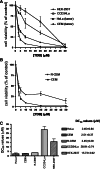Cell-permeable dual inhibitors of protein kinases CK2 and PIM-1: structural features and pharmacological potential
- PMID: 24442476
- PMCID: PMC11113908
- DOI: 10.1007/s00018-013-1552-5
Cell-permeable dual inhibitors of protein kinases CK2 and PIM-1: structural features and pharmacological potential
Abstract
It has been proposed that dual inhibitors of protein kinases CK2 and PIM-1 are tools particularly valuable to induce apoptosis of cancer cells, a property, however, implying cell permeability, which is lacking in the case of selective CK2/PIM-1 inhibitors developed so far. To fill this gap, we have derivatized the scaffold of the promiscuous CK2 inhibitor TBI with a deoxyribose moiety, generating TDB, a selective, cell-permeable inhibitor of CK2 and PIM-1. Here, we shed light on the structural features underlying the potency and narrow selectivity of TDB by exploiting a number of TDB analogs and by solving the 3D structure of the TDB/CK2 complex at 1.25 Å resolution, one of the highest reported so far for this kinase. We also show that the cytotoxic efficacy of TDB is almost entirely due to apoptosis, is accompanied by parallel inhibition of cellular CK2 and PIM-1, and is superior to both those observed combining individual inhibitors of CK2 and PIM-1 and by treating cells with the CK2 inhibitor CX4945. These data, in conjunction with the observations that cancer cells are more susceptible than non-cancer cells to TDB and that such a sensitivity is maintained in a multi-drug resistance background, highlight the pharmacological potential of this compound.
Figures







References
-
- Li R, Stafford JA. Kinase inhibitor drugs. New York: Wiley; 2009.
-
- Pinna LA. Protein kinase CK2. New York: Wiley; 2012.
Publication types
MeSH terms
Substances
LinkOut - more resources
Full Text Sources
Other Literature Sources
Miscellaneous

